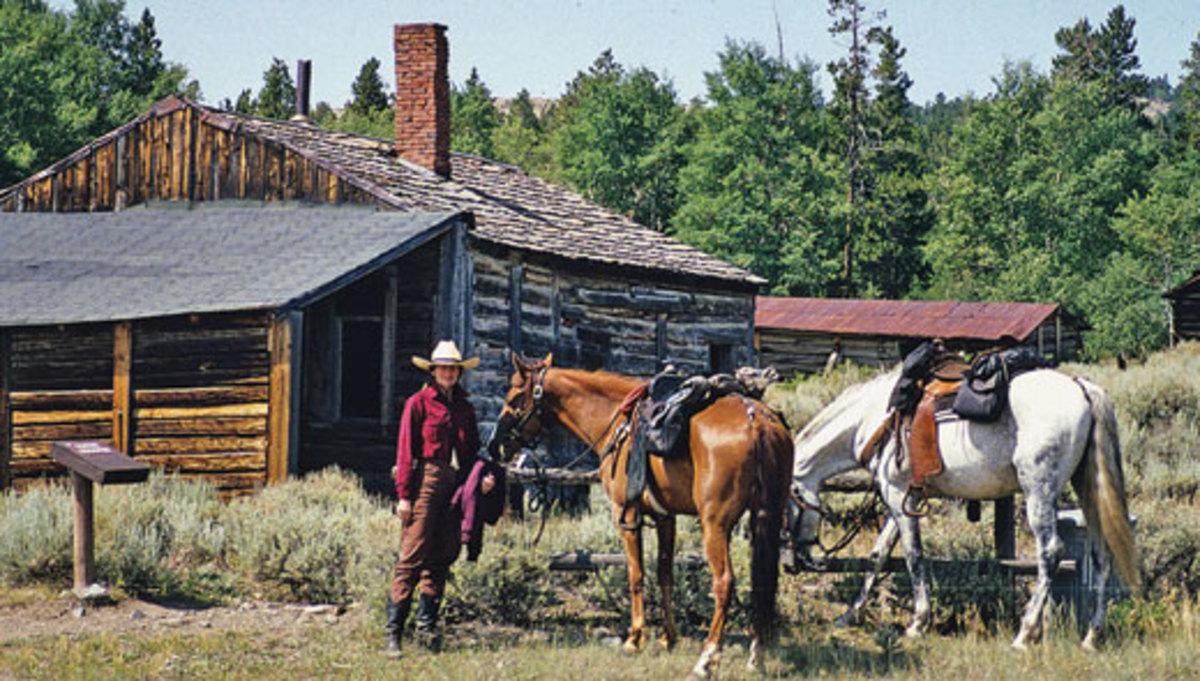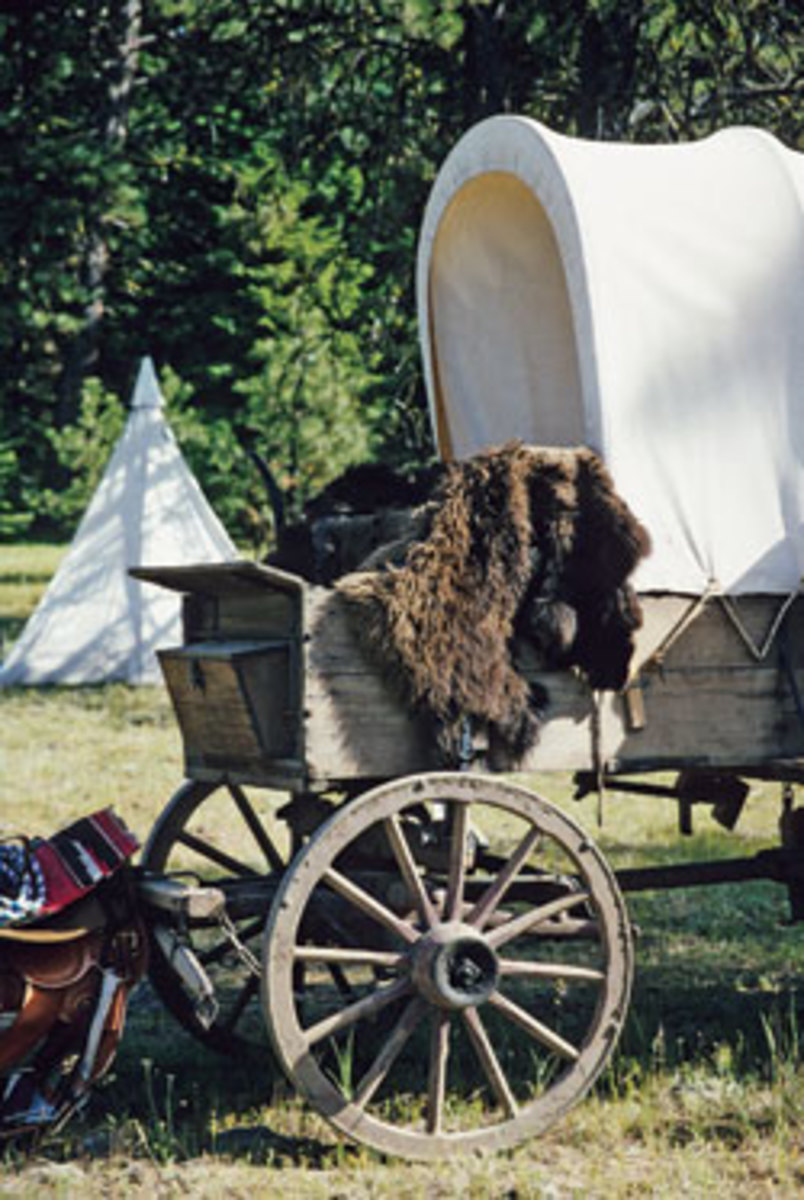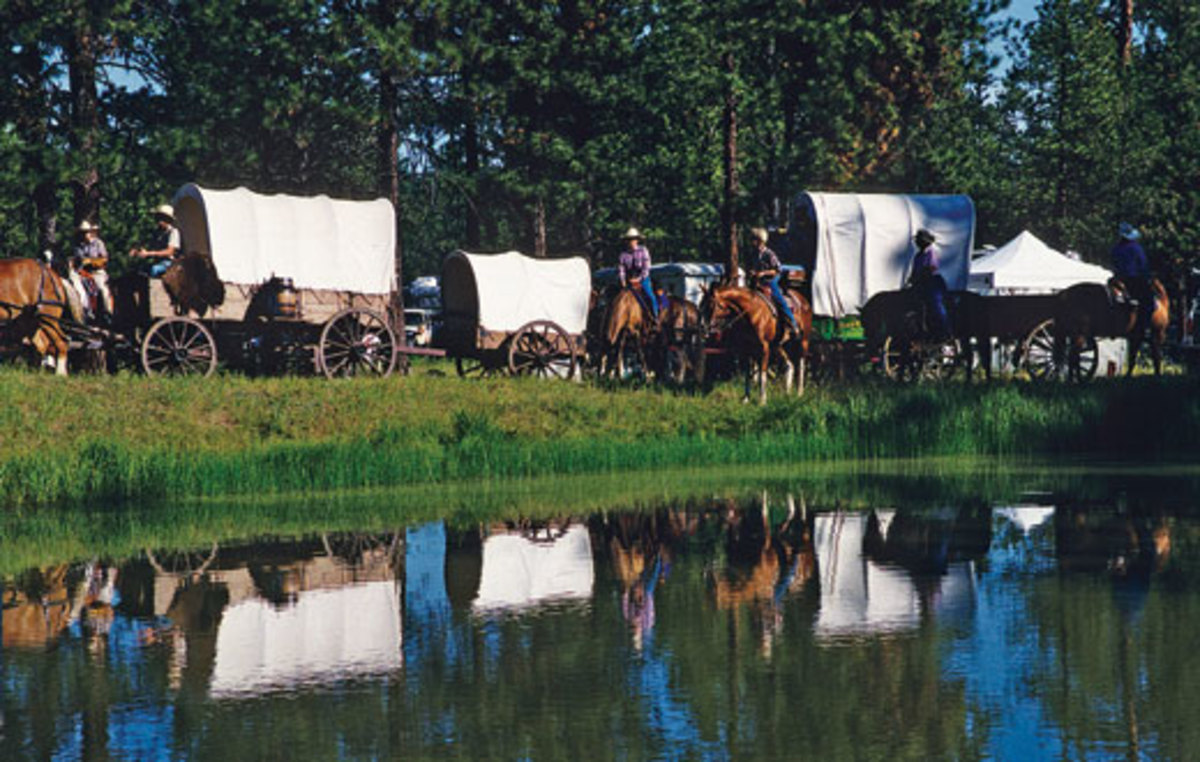
Oregon or bust! The Oregon Trail was the route of the world’s greatest peacetime migration. From the early 1830s to the mid-1880s, around 500,000 people traveling west to Oregon, California, and other points in the Pacific Northwest traveled on the Oregon trail; 50,000 died along the way. From Independence, Missouri, to Oregon City, Oregon, the trail is 2,170 miles in length.
We wanted to ride our horses along portions of the Oregon Trail and visit historic sites. We developed a two-pronged approach to our exploration: First, we’d ride sections of the trail in Wyoming and Idaho on our own. To cap things off, we’d then ride with a wagon train in Oregon.
Along the Trail
Our tour of the Oregon Trail started at Fort Laramie National Historic Site in Wyoming (307/837-2221; www.nps.gov/fola). We’d planned to go east to west, just as the early settlers did. Fort Laramie gives visitors a feel for pioneer life in a fort and on the trail. The fort, established in 1849, became a major supply point for Oregon Trail travelers. Restored and original buildings are open for touring. These buildings include Old Bedlam; built in 1849, it’s the oldest existing structure in Wyoming.
Of special interest to us horse folks are the cavalry barracks built in 1874. Cavalry gear, beds, and the whole works are on display. Charlene thought it was especially interesting the way soldiers carried their tents. Each soldier had a “tent buddy,” who carried one-half of a tent to save excess weight on the horse.
About a day’s wagon travel west of Fort Laramie is the town of Guernsey. Follow the signs from there to Register Cliff State Historic Site, where a sandstone cliff bears hundreds of names, dates, and hometowns of pioneers who passed that way in the mid-1800s. All have tales to tell, if they could only speak.
Look for the Unthank family (A.H. and O.N.) who carved their names in the cliff in 1850. After carving his name, A.H. Unthank lived only one more week before dying of cholera. His grave is down the trail near Glenrock, Wyoming.
Near Register Cliff are impressive ruts formed by wagon wheels. Follow signs to the Oregon Trail Ruts State Historic Site, known as the Guernsey Ruts. The terrain in this area forced wagons to cross a sandstone outcropping. Over the years, thousands of wagons wore ruts into the soft stone to a depth of five feet in some places. Look closely at the side walls, and you can still see where wagon-wheel hubs rubbed against the walls.
We stopped at nearby Guernsey State Park (307/836-2127; https://wyoparks.state.wy.us/guslide.htm) for a place to ride our horses and camp. We checked with Wes Gudahl, the assistant superintendent who said it was fine to camp with horses in the park. There are two looped trails with a combined distance of 6.2 miles. However, we found we could extend our ride by going cross country. (Pick up a trail map at the museum.)
We enjoyed riding our horses through small canyons, prairies, and buttes dotted with juniper and ponderosa pines. We saw a large number of birds and a few mule deer meandering in the distance. We could catch glimpses of Guernsey Reservoir and the North Platte River. During late summer, the reservoir is completely drained. This may not be a desirable time to visit if you don’t like looking at an empty lake bed!
We continued following the Oregon Trail west on Highway 220 to Independence Rock. This rock is 136 feet high and about a half-mile long and is covered with emigrants’ names. To see the best displays of names, walk to the back side of the rock and climb to the top.
William Sublette named this rock on July 4, 1830, as he paused to celebrate Independence Day while leading the first wagon train to cross the new overland route. Pioneers heading west tried to time their start so the spring grass would be sufficient to support the animals, but early enough to avoid risking early snows in the mountains. If they reached Independence Rock by the Fourth of July, they knew their timing was about right, and they had huge celebrations.
As we stood on top of the rock looking to the plains where the wagons rolled, we were overcome by feelings of the human tide that had flowed below us going west to seek new fortunes.

Crossing the Divide
South Pass was the lowest, easiest route for wagons to cross the Continental Divide, our nation’s backbone. Captain Benjamin Bonneville took the first wagons over South Pass in 1832. After that, hundreds of thousands of emigrants crossed on their way west. Nearby is South Pass City State Historical Site (307/332-3684; https://wyoparks.state.wy.us/spcslide.htm).
South Pass City was built during a gold rush in 1866. By 1870, there were 4,000 residents. The gold dwindled out, but the town remains today, restored by the state of Wyoming as an example of an early mining town. It contains more than 20 original buildings, including an authentically furnished hotel, a saloon where you can play on an 1800s billiard table, and a stocked general store.
We went on several rides near South Pass City. We began the first by riding our horses right through town and down Main Street. You’ll need to stop at the visitor center to get permission to ride through town and for them to open the gate.
The trail through town and beyond is a Volksmarch trail. Volksmarch means “a walk of the people.” The Wyoming State Parks and Historic Sites Organization created Volksmarch trails in 10 of its state parks. The trails are marked by brown-and-yellow signs.
As we rode our horses through town, we tried to imagine what it would’ve been like to have ridden there 140 years ago. We passed the same board sidewalks and buildings that people used in earlier times. It was a real thrill to ride past historic buildings while tourists watched.
We briefly paused at Esther Morris’ cabin. In 1870, she was appointed justice of the peace, making her our nation’s first female judge.
We rode our horses for about 2.5 miles past South Pass City following Willow Creek. This is a small canyon with willows growing along the stream. The trail markers weren’t all in place, so we couldn’t see exactly where the official trail went. We started traveling cross-country, leaving the creek and climbing aspen-covered hills to the north.
We came to an old mine that had a wheel-type structure at the top of the mine shaft. It appeared that a horse or mule would turn the wheel to raise and lower a cable in the shaft. We selected our own route, working through ravines, hillsides, and pockets of timber until we came back to town.
There are two other rides of interest in the South Pass City area. The first ride is to the old ghost town of Miner’s Delight. To do this ride, we trailered five miles to Atlantic City, also an interesting old mining town. Robert Redford came here for food and drink in the old saloon while doing research for his book, The Outlaw Trail.
You can drive on mining roads to Miner’s Delight, but we actually made about a 12-mile loop from Atlantic City to Miner’s Delight by riding on roads and cross-country. We rode to Roundtop Mountain, followed Peabody Ridge, went down Horace Gulch, and back up Little Beaver Creek. We were able to do some side exploring, and discovered a number of interesting mining and early day sites.
If you go, pick up a map of the area from the South Pass City visitor center, or order a detailed topographical map. If you order the latter, specify Miner’s Delight, WYO, 1991, 7.5 minute series (888/ASK-USGS [275-8747]).
Miner’s Delight has been restored by the Bureau of Land Management. We had an enjoyable time exploring the old buildings and the nearby cemetery. The town was founded in a gold rush in 1867. It also has the distinction of being Calamity Jane’s childhood town. Calamity Jane was born in Missouri and orphaned at an early age; her adoptive parents brought her to Miner’s Delight.
Another fun ride is directly northwest across Highway 28 from South Pass City. You can easily see this area on a map of the Shoshone National Forest, South Half. We simply started up Forest Road 320 and rode cross-country and along old roads that meandered through the hills. We had a nice time riding around and through open parks, patches of timber, and rocks.
At one point, our horses spotted a moose running through the brush. Altogether, we enjoyed some great riding around South Pass.
Joining Up
Now it was time to join up with a real wagon train and ride along with our horses. We were invited to join the Pendleton Roundup Association’s wagon train for a five-day trip near Ukiah, Oregon. For this trip, our two cousins, John Kiczek and Tess McCarihan, flew out from Ohio to join us.
We had Buddy and Scout, our two Missouri Foxtrotters; Buckwheat, our tried-and-true Appaloosa; and Gator, a horse we leased from Montana Horses Company in Three Forks, Montana (888/685-3697). Four people and four horses. We were ready to go!

We picked up John and Tess at the airport and drove to the campsite. There were 18 wagons and 171 people on this journey. There were all types of wagons, from covered wagons to surreys. People could either ride in wagons or on a horse. Food, horse hay, and evening entertainment were included in the price. We had our pickup and camper, which was shuttled from camp to camp. People also slept in tents or in their wagons.
Unfortunately, on the first day out, a driver became injured, as often happened on Old West wagon trains. A team of mules startled and bolted, flipping the driver off the wagon. The wagon ran over him, breaking several of his ribs. He was airlifted by helicopter to a hospital. Later, we found out that he would make a full recovery.
Goodbye, Buckwheat
A true tragedy happened when our horse, Buckwheat, became very ill and died. We were unable to save him, in spite of a valiant effort on the part of a veterinary technician, a small-animal veterinarian, and two excellent equine veterinarians – Mark Omann, DVM, and Chris McIlmiol, DVM, both of La Grande, Oregon.
Buckwheat was the most courageous, trustworthy horse we’d ever owned. He’d traveled the Continental Divide Trail from Mexico to Canada, had been in most of the western wilderness areas, and had ventured twice into the Canadian Rockies. He was the subject of an article in the July/August ’03 issue of The Trail Rider (“Thank You Buckwheat”) and was featured on the cover of the July/August ’05 issue.
When Dr. Omann saw the cover photo of Buckwheat in the beautiful Canadian Rockies, he said, “Buckwheat’s already been in heaven.” Later, Dr. Omann sent us a letter that read, “The loss of Buckwheat will long leave that shadow in the corral when you go out to get the ponies for your next ride. I hope the character he was will be the glowing coal in your campfires that bring only smiles and fond memories to quickly douse your pain and sadness at his loss.”
At our nightly gathering, Charlene gave a tribute to Buckwheat and told the wagon-train folks about his life. Buckwheat is buried near the Oregon Trail, not far from his ancestral land where the Nez Percé Indians originally bred the Appaloosa breed.
Wagon-Train Adventure
We were down one horse, but true to wagon trains of olden times, people came forward and offered us their support and help. We were invited to ride in several wagons and were even loaned a spare horse. Cousin John had very little horse experience and had planned to ride Buckwheat. As it turned out “Buckeye John” rode like an old cowboy and had a great time riding several different horses. We also took turns riding in wagons.
Cousin Tess had a memorable ride with teamster Dave Peterson. Dave had an authentic covered wagon that pulled another small wagon behind it. As they bumped and traveled along, Dave told Tess tales and adventure stories. Some were even true! Dave and his wife, Debra, have their own wagon-train business, Wagons Ho! (See “Wagon-Train Resources” on page 74.)
A typical day on the wagon train started out with an all-you-could-eat cowboy breakfast. The teamsters and wagons pulled out first, with folks on horseback following. We rode far to the side or behind the wagon train, which not only enabled us to explore, but also enjoy great views of the wagon train from a distance.
It’s a rare treat to see 18 wagons pulled by horses moving along through fields bordered by aspens and pines with views to distant mountains. At 4,800 to 5,000 feet above sea level, we could see the plains to the west and the Blue Mountains to the east.
Wagon trains can be scary monsters for saddle horses that aren’t used to them. Things move and jangle. Try to accustom your horse to wagons before investing in a wagon-train trip. Our horses did a great job. Tess was thrilled with how well Gator behaved. It was probably the first time he’d ever seen such a sight. My horse, Buddy, is just a kid and interested in everything. I expected more trouble from him, but he was a champion.
Our horses moved faster than the wagon train, so we’d travel up ravines, through moist valleys, and on flower-covered mesas. The whole area was essentially a large, flat plateau, where it’s easy to become disoriented and lost. As a precaution, we kept an eye on the wagon train in the distance.
Every night, we’d all meet and discuss the day’s events. Generally, there’d be evening entertainment in the form of drawings for prizes, singing, and fiddle playing.
The last night of the wagon train, a cowboy band played. As the sky grew dim and the stars came out, we danced the night away. It made us think back to how the early settlers danced and celebrated at Independence Rock. A century-and-a-half later, we were doing the same thing.
And just as in olden times, our trip had triumph and tragedy, joy and sadness. We’d take home memories to last a lifetime of the wonderful people and events that made up our experience along the Oregon Trail.




